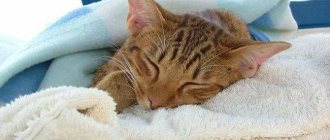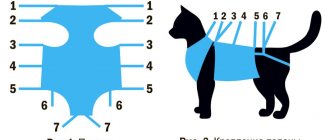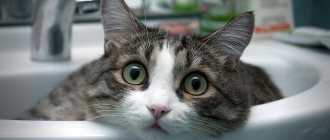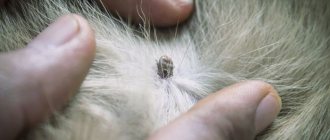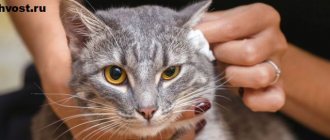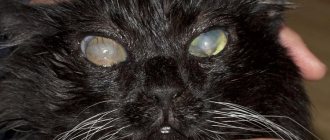Pregnancy and childbirth (lambing) in cats are natural processes characteristic of unsterilized pets. In most cases, they proceed without complications, but sometimes the owner’s help is required. Complications are typical for primiparous, purebred and dwarf cats, as well as for those who are sick with congenital or acquired pathologies. In such cases, mandatory provision of step-by-step assistance is required throughout the entire lambing.
Necessary preparation
After successful conception, the formation of future kittens begins, which takes 60-65 days. During this time, it is recommended to find a veterinarian who is ready to provide emergency medical care at home in case of complications.
Arrangement of the place
During and after birth, the cat will need a secluded corner. It is better to prepare it in advance. Otherwise, the pet will hide under the sofa, which will prevent free access to her and the kittens. To build and equip a “maternity hospital” you will need:
- Big box. Make sure that it will accommodate not only the new mother, but also her offspring.
- Soft bedding or blanket. Place a disposable baby diaper under them to prevent the cardboard from getting wet.
- Bowls for water and food. You also need to add a tray. After giving birth, the cat should rest and not run to the other end of the house to relieve itself.
The constructed space must be accessible and spacious. Isolate it from possible threats (children, other pets, drafts) by choosing the quietest and most secure room in the house.
What materials, tools and medications may be needed
A week before the onset of a responsible time, prepare an “alarm suitcase”. He must be kept close until contractions begin. The content should be as follows:
- antiseptics and Oxytocin;
- small syringe;
- cotton pads and gloves;
- water container;
- separate box for newborns;
- clean towels or cotton fabrics;
- sterile threads and napkins;
- warmer;
- pipette and rubber bulb;
- scissors disinfected with alcohol;
- dry milk mixture.
All these things should be stored in one place. The number of tools and materials needed depends on the severity of the lambing.
What not to do
Cats usually give birth when it's late afternoon or even night. During this time, the pet should not be left alone. Take care of completing all the tasks in advance and give your pregnant pet maximum attention.
In case of complications, contact your veterinarian immediately. Trying to fix the problem yourself can kill the animal. Also, avoid using Oxytocin until the last minute. This drug is used to stimulate labor strictly in the presence of certain factors. If the process takes too long, but is not accompanied by complications, be patient. The body will cope with the birth of babies on its own at a pace that is convenient for it.
Place for birth
The place where the cat will give birth to kittens also needs to be prepared in advance. This could be a house from a pet store, a cardboard box, or even a cabinet drawer. It is important that it is sufficiently closed and spacious, but at the same time not too large - the expectant mother should feel safe and calmly feed the kittens.
Place the “maternity ward” away from drafts, bright light and doors: the place should be secluded and darkened. Place a small mattress at the bottom of the box or drawer, then lay down an oilcloth, and place a regular baby diaper on top.
Often cats themselves choose the place for future births. If you do not approve of this choice, you will have to constantly move it to a specially equipped place. To allow your pet to get used to the shelter, it needs to be prepared as early as possible.
How to recognize the onset of labor
Inexperienced owners worry more than their pets. They ask in advance how to understand that a cat has started giving birth, and how long to wait for the kittens to appear. Veterinarians advise monitoring the behavior and well-being of your pet throughout pregnancy. This will help you easily recognize changes at an early stage.
Behavior of the expectant mother
The first signs of labor in a cat involve behavior. The expectant mother is nervous, anxious, constantly looking for a secluded corner and trying to build a nest. Because of this, it is important to accustom her to a prepared box in advance.
A pregnant woman's appetite decreases to the point of hunger strike. She constantly licks the external genitalia, and a few hours before lambing begins to arch her back. With a strong attachment to the owner, the animal begins to attract his attention by meowing.
Physiological signs
Physiological signs include swelling of the mammary glands, the appearance of lactation and a decrease in body temperature to 37 °C. The pregnant belly drops and takes on the shape of a pear. The frequency of going to the toilet increases. 1-2 days before the onset of labor, the mucous plug comes off. It is difficult to notice the passage of water, since the secreted mucus is constantly licked out.
How to prepare a cat for birth
A caring owner begins to prepare the cat for childbirth even before mating begins.
It is important to make sure that the pussy is healthy: an active lifestyle of the animal will contribute to the normal course of pregnancy and childbirth. However, towards the end of the term, it is better to ensure that the cat does not try to “take heights”, does not jump from cabinets and other high objects in the house: it can easily fall on its stomach.
On the contrary, you should try to stimulate British cats during pregnancy - these sloths are quite capable of lounging on the bed for a long period of time. And low mobility will not lead to a good result.
It is better to contact the veterinary clinic in advance and find out whether you can get an urgent consultation at any time of the day at “hour X”, and whether the institution provides the opportunity to give birth to cats at home .
Preparing the birth site
Just as a woman needs a breeding room, a cat needs a place to give birth to her offspring. It is best if it is something resembling a house for giving birth to a cat. In this place, not only will the fluffy balls be born, but also their first weeks of life will pass.
Why is it so important to prepare a place for your cat to give birth in advance? If she does not feel calm and protected, she will begin tossing around before the onset of labor, and then frantically dragging the kittens in search of a safe place.
How to help your beloved pussy during childbirth? Take care of everything in advance! What to make a house from: any spacious box will do, preferably with a removable top lid. A disposable absorbent diaper is placed in it. It makes sense to prepare in advance all the items that will help during obstetrics and place them close to the “maternity” house.
Stages of childbirth in a cat
Familiarize yourself in advance with how cat birth works. This will eliminate anxiety and give an understanding of the natural state of affairs. The process proceeds in stages. The first and second stages alternate with the arrival of the new kitten. The third proceeds the fastest and indicates the end of the process.
Contractions
After the water breaks, the uterus begins to contract intensively. The diameter of the perineum increases, contractions that occur are replaced by periods of calm. The pet's breathing quickens. She constantly runs to the box and drops the blankets. This interval lasts 3-6 hours. At this time, you can easily feel the movement of the kittens by placing your hand on the mother's belly.
As contractions become more frequent, the furry babies are pushed out more and more. A small amount of blood may be released from the birth canal.
The appearance of kittens
The appearance of pain during contractions that become more frequent means that the first baby will be delivered soon. Try to calm your pet down with petting and gentle words. When pushing, the amniotic sac bursts and releases a small amount of yellowish fluid. This stage takes 5-30 minutes and is accompanied by loud purring or growling.
The appearance of the placenta
The placenta is the amniotic membrane, that is, the placenta, which comes out immediately with the kitten or a little later than its appearance. After it was all over, the young mother's condition stabilized. Calm and even breathing returns to her, uterine contractions decrease, and the abdomen becomes soft and elastic.
Birth of the fetus
As soon as the kitten comes out, it is covered in a shell. The mother must carefully tear it apart and bite off the umbilical cord. The cat begins to intensively lick the baby, which helps clear his respiratory tract of mucus. The kitten should squeak - this is a sign that it is breathing. After or along with the kitten, the placenta comes out, which the mother can eat. If the offspring is large, you should not let her eat more than 3 afterbirths.
You need to make sure that all traces come out. Their number should correspond to the number of fruits. The placenta remaining inside can cause serious inflammatory diseases.
In the intervals between births, it is necessary to ensure that the mother does not lie on the newborn kitten. Due to the pain and discomfort, she may not notice it and accidentally press it down.
When all the babies are born, it is necessary to organize complete peace for the family. The mother will lick and feed her babies, so there is no need to disturb them too much. If a cat has eaten the afterbirth, she may not eat for several hours after giving birth. It is necessary to leave her something to drink and place a toilet nearby so that she does not go far from the offspring.
Description of the birth process
Inexperienced owners are primarily concerned about the length of the process. The condition of newborns and their possible number are also important.
How long does labor last?
It is impossible to give an exact figure that determines how long a cat’s labor lasts. This indicator is individual. It depends on age, breed and general health. Typically the entire process takes 4-12 hours. If the duration lasts for a day, it is recommended to contact a veterinarian. A negative prognosis is typical when it reaches 48 hours. In this case, urgent surgery is required to save the animal and its offspring.
You can determine how long it will take for a cat to give birth to the next baby by looking at its order. The first two take the longest to come out. The wait may last for several hours. The birth time of the remaining kittens is a few minutes.
How many kittens can be born?
When talking about how cats give birth, it is necessary to note the size of the possible litter. On average, the number of newborns ranges from 2 to 6. Their number depends on the previous pregnancies, breed and age of the woman giving birth. A small number of newborns (1-3) is typical for primiparous, elderly and small pets.
What do newborn kittens look like?
The weight of newborns is 80-120 g, and their body length is 9-12 cm. They are born deprived of sight and hearing, so they really need help from their mother or a person. At first, they sleep constantly and eat a lot. Due to fragile bones, babies cannot stand on their feet. They navigate with the help of a developed sense of smell and touch and use a thin squeak to communicate. At first it is better not to touch them. It is enough to monitor their weight.
How to determine the end of a process
The absence of contractions for 2 hours indicates the end of labor. Full recovery of the body takes 2 weeks. During this time, newborns grow up and become more independent.
What to do with kittens if there are a lot of them?
If a cat has given birth to many kittens, it will be difficult for her to care for her babies without your help. First of all, you need to organize proper and timely feeding of newborns. To do this, you will need special milk that replaces cat milk. You can buy it at a veterinary pharmacy.
For feeding you will need a special bottle with a tiny nipple. This accessory is also sold in pharmacies and specialized pet stores.
Newborn kittens need to be fed small portions every 2-3 hours. As you grow, the dosage is gradually increased. You can find out the exact amount of daily food for newborn kittens from your veterinarian. This issue is especially important to discuss with a specialist if the cat gave birth to premature kittens.
Features of some genera
Knowing only in general terms how cats give birth is not enough. For effective home care, it is recommended to delve into the possible nuances of different animals.
In purebred cats
British and Scottish women cannot do without veterinary care. These representatives often encounter problems when trying to push out an overly large fetus on their own. Veterinary obstetric assistance is required for safe passage through the birth canal.
In a primiparous cat
The first time a cat gives birth takes longer and is more difficult. It will not work to sit on the sidelines, reducing all help to approving words and strokes. The young pet experiences more than its owner. The first birth of a cat is characterized by weak contractions with a long break between them.
Premature birth
If kittens were born prematurely (50-55 days), then this is considered normal only for long-haired breeds. Early contractions in other representatives are caused by serious problems:
- non-viability of offspring;
- internal injuries;
- placental abruption.
In these situations, some babies are stillborn. If the number of stillborns is no more than one, then there is a chance to save the remaining fetuses. To do this, it is recommended to undergo a full examination at a veterinary clinic.
Late labor
The absence of labor for more than 70 days is caused by a false or frozen pregnancy. In the second case, the entire litter dies inside the womb. Advanced decomposition processes are fraught with infection and damage to the uterus. The animal requires urgent surgery.
Main stages of complete labor
When labor begins, your cat's body temperature rises and her ears and nose become hot to the touch.
During contractions, the cat breathes heavily with an open mouth. At this moment, she can be in a sitting position or lying on her side.
What happens next:
- The first kitten emerges from the cat's genitals. It is very good if the baby steps forward with his front paws.
- After the birth of the first kitten, there is a break lasting from 10 minutes to a whole hour. Remain calm, this is a normal birthing process for animals!
- When the kitten comes out into the world, don’t even try to pull its paws! Any wrong move can have negative consequences. If there is an urgent need, you can gently pull the baby’s body or skin folds near the neck. Proceed carefully and do not use physical force. Pre-lubricate your hands with Vaseline.
- After each kitten is born, the placenta comes out. The cat eats it. You need to monitor this process carefully. Firstly, the placenta should come out after each kitten is born. If this does not happen, it means that the placenta remains in the mother’s body. This is very dangerous for her health. To prevent complications, take your cat to the veterinarian after birth. An experienced doctor using special tools will carefully remove the remaining placenta from the cat’s reproductive organs. Secondly, a woman in labor should not eat more than two placentas. This may cause stomach upset.
- Kittens are born in the amniotic sac. The mother cat must gnaw the umbilical cord and bite through the bladder.
- Take the baby in your arms, turn him head down and shake him a little. With this movement, little water leaks out of the nose, after which he will be able to breathe on his own.
- Give the newborn baby to the mother. She will immediately begin to lick the kitten to clean its delicate skin of mucus and other natural contaminants.
Well, now wait for the birth of the next kittens. Everything will happen according to a similar pattern. As soon as the cat calms down and starts feeding the babies, you will understand that the birth was successful and all the worst is over!
We invite you to look at the photo of the first minutes of newborn kittens with their mother cat!
How to deliver babies of varying degrees of complexity at home
Assistance to the woman in labor depends on the severity of the lambing. It is impossible to predict its outcome in advance, so you will have to act according to the situation.
Lungs
For mild lambing, no intervention is required. You just need to ensure the safety of newborns. During labor, the mother may crush them, so place the kittens in a separate box until the last baby appears.
Compare the number of newborns and placenta. The lack of placenta is caused by getting stuck inside the womb, leading to inflammation. You will have to remove it yourself by wrapping your fingers in a clean bandage. If pus, mucus or blood appears, lambing is considered moderate or severe.
Average
At the end of labor, the new mother independently gnaws the umbilical cord, eats the afterbirth and cleanses the newborns of mucus. If she did not do this, you will have to play the role of an obstetrician. Carefully cut the umbilical cord 4 cm from the abdomen, tie it with thread and treat the wound with an antiseptic.
Before cutting the umbilical cord, remove membranes from each kitten and clean their nasal passages and mouth using a pipette or bulb. If there is no breathing or a characteristic squeak, carefully fold the baby in half, rub him with a towel and gently shake him upside down.
Do not give your pet more than two afterbirths. They are rich in beneficial microelements and have a beneficial effect on the immune system, but cause gastric upsets if consumed in excess. If the bubble does not burst inside the vagina, the pet may try to burst it along with the kitten. Discourage this action by noticing a bubble emerging from the vagina. After the newborn arrives, carefully open the amniotic sac, being careful not to touch the tiny body.
Complex
Complex cases include stopping labor. This can happen when the fetus gets stuck or several babies are pushed out at the same time. To save them, you will have to wear disposable gloves, lubricate your fingertips with Vaseline and carefully insert them into the vagina in an attempt to grab the withers. Avoid paws. They are too fragile and can be easily damaged. Pull your newborn out using gentle rocking movements.
If you notice an unpleasant-smelling brown fluid coming out of the vagina or prolonged labor, you should contact your veterinarian. It is also recommended to clarify in advance the number of future offspring using an ultrasound scan, so as not to miss the stuckness of the fetus.
Giving birth to a cat at home
A responsible owner should know how to give birth to a beloved cat . First, prepare everything you need:
- a house that the cat will examine and “accept” in advance;
- towels or absorbent diapers;
- clean cloths or gauze;
- thick silk thread;
- scissors with rounded ends;
- alcohol for disinfecting scissors;
- hydrogen peroxide;
- streptocide in powder form;
- a pipette or syringe that can be used to suck out liquid from the baby’s nose;
- afterbirth bowl;
- warmer.
Easy birth
A cat's birth is considered easy when there is no need for human intervention. It will be enough to simply be close to the woman in labor. The main thing you need to take care of is that the mother should not accidentally crush her offspring. It is also important to monitor whether each afterbirth has come out. If suddenly some placenta is missing, then the cat’s discharge is observed for several more hours; the process may take a little longer.
An easy birth is not characterized by pus, mucus and blood.
Middle birth
Sometimes some complications arise during home birth. If the process is delayed, you need to stroke the cat from the side of the neck to the uterus.
If the cat is distracted and does not chew the umbilical cord, a person does this, treating the cut site with iodine. The newborn may not breathe: minor resuscitation will be required. The respiratory tract is cleared of mucus using a pipette or suction, and the oral cavity is examined. Anything that should not be there is removed with a rubber bulb. If breathing does not appear, the baby is picked up and carefully folded in half - several times in a row. You can also rub the baby with a rough towel and gently shake it upside down.
Difficult birth
global $ads_google;
//data-ad-slot=”2475549904″ $ads_google = empty($ads_google) ? false : true; ?> if ($ads_google == false) {?> $ads_google = true; ?> } ?> Childbirth turns out to be difficult when, despite everything, the kitten is not born on its own: the baby gets stuck in the birth canal, or two babies try to be born at the same time. Before calling the veterinarian and hoping for a caesarean section, there are a number of independent steps to take.
You need to understand that it is better to act and help the cat during childbirth than to later regret the misfortune that happened.
If labor stops or its result is zero, the cat can be taken for an ultrasound or x-ray. It may turn out that the kitten has died, or it is extremely large and has blocked the exit.
Sometimes it is necessary to turn the kitten over: a gloved index finger, lubricated with Vaseline, is inserted into the vagina. You need to carefully push the baby back and try to turn him over. If it is simply stuck, then it is picked up under the hanger and carefully pulled out with attempts.
How and why to induce labor
Stimulation of labor is used in cases of late lambing or a prolonged interval between the birth of babies (more than an hour), when the pet cannot give birth on its own. During obstetrics, it is recommended to start with a light massage of the abdomen and nipples.
In an emergency, an injection of Oxytocin, a drug that accelerates uterine contractions, is allowed. It is used only after a preliminary conversation with a veterinarian. An incorrect dosage can lead to rupture of the cervix and cause the death of the mother and her offspring.
What will you need during childbirth?
Not every cat may need help with lambing. Animals usually cope on their own, but human presence is still necessary to monitor whether everything is going well. Having discovered signs of approaching labor, you need to prepare materials and tools:
- clean diapers or towels;
- gloves;
- a syringe to remove mucus from the nose of newborn kittens;
- threads for tying the umbilical cord;
- scissors (sterilize);
- petrolatum;
- waste container;
- greenery.
The owner of the animal must have medications at his disposal, thanks to which the birth will take place without complications. These include:
- Gamavit. They begin to use it 5–7 days before the expected date of birth of the kittens. Used as subcutaneous injections 1 time per day, 1 ml. Also, the injection is given immediately after the start of contractions. Gamavit is given to kittens immediately after birth (3 drops in the mouth) and over the next 3 days, once a day.
- Calcium gluconate. During labor and after birth, the cat is injected with 1–2 ml under the skin in the withers area. This will prevent eclampsia.
- Oxytocin. Used to stimulate labor if contractions suddenly stop. The medicine is administered subcutaneously. Dosage – 0.3 ml. The hormonal drug can only be used on the recommendation of a veterinarian.
- Mastomethrin. A medicine that prevents the development of mastitis after childbirth. The drug is administered intramuscularly in a dosage of 0.5–1 ml once a day for 3 days.
Condition of cats after birth
After the end of labor, the new mother needs to recover. Watch her carefully. If alarming signs appear, take your pet to the veterinarian.
Normal phenomena
In the first week, a small amount of pinkish vaginal discharge is acceptable. If you are under extreme stress, you may lose milk. This is not a pathology, but implies a forced transition to artificial feeding.
For the first 5-6 hours, a new mother may refuse to eat. It's okay if she enjoys drinking water. Otherwise, dehydration and exhaustion of the body may occur. Temporary suspension of trips to the toilet is also allowed. Most of the liquid goes into the milk, so the pet may not go to the toilet for up to 4 days in a row.
Complications requiring treatment
The help of a veterinarian is needed to perform a cesarean section or eliminate complications that arise in a cat after birth. Dangerous complications include:
- an abundance of bloody or purulent discharge with an unpleasant odor;
- uterine prolapse;
- inflammation and hardening of the mammary glands;
- excessive increase (more than 39.5 °C) or decrease (less than 37 °C) in temperature;
- impaired coordination of movements and heart rhythm;
- weak breathing of the woman in labor;
- plaque on mucous membranes and lethargic behavior of newborns;
- frequent urination.
Heavy bleeding after a cesarean section indicates ruptured sutures, as well as tears inside the vagina. In this case, urgent veterinary attention is required. Preserving the belly for more than a day after lambing is no less dangerous. Most often this is due to fetal stuckness or helminthic infestation.
The most dangerous complication is eclampsia - a sharp increase in blood pressure. This condition is accompanied by excessive salivation, convulsions, fever and loss of coordination. If you notice these signs, contact your veterinarian immediately. An animal left without timely treatment dies.
Veterinarians recommend contacting the clinic if you have any doubts about your actions. It is better to make a mistake in your conclusions and make a false call than to kill your beloved animal and its offspring.
How to deliver a cat correctly
Never panic, even if you are very worried about your pet. Cats sense their owner's mood very well, and if she realizes that you are on the verge of a breakdown, she will also begin to get nervous, which will only worsen the birth process.
During contractions, stroke the cat's belly; such movements have a good stimulating effect.
If the cat has not chewed the umbilical cord, follow these steps:
- Tighten the umbilical cord with a thread 2 cm from the baby’s tummy;
- carefully cut from the opposite end with disinfected scissors;
- Treat the cut area with an antiseptic solution.
How to care for a cat and kittens
Change the new family's diapers and leave them alone. Newborns have little fur, making it difficult for them to stay warm. Hang a lamp over the box to prevent them from freezing.
Cat food
A young mother feeds her offspring for up to 2-2.5 months. This requires a lot of effort, so pay special attention to her nutrition:
- Purchase quality food formulated for pregnant and lactating animals.
- Focus on fermented milk products. If you adhere to natural feeding, then take care of a sufficient amount of calcium. All other food should be easily digestible: boiled lean meat, vegetables, cereals. The amount of meat in the first 10-12 days is reduced to a minimum.
- Add magnesium and calcium to your diet. Additional nutritional supplements will be needed when eating natural foods. Before using medications, be sure to consult your veterinarian.
- Change the water regularly. Bacteria in the water will immediately affect newborns.
At first, the frequency of feeding increases to 4-6 times a day. Portions should be small and balanced.
A first-time pet often leaves her family due to poorly developed maternal instinct. Don't scold her, but calmly bring her back. After several returns, she will understand what is required of her.
Feeding kittens in the absence of milk
Mother's milk cannot be replaced with cow's milk. A cat's body can only digest milk of its own species. Consumption of milk from other animals is fraught with acute intestinal upset followed by dehydration. Also, with such feeding, there is a lack of essential nutrients. In the long term, there is a lag in development and the formation of weak immunity. The pet is vulnerable to viral infections and chronic diseases.
As an alternative, the use of cat milk replacer is recommended. It comes in liquid or powder form and is sold in veterinary pharmacies and pet stores along with a feeding bottle. Recommended dosages are indicated on the packaging.
as a temporary substitute for the mixture:
- 1 tsp. glucose powder, diluted in 1 glass of boiled water;
- rice water obtained after boiling rice by straining out the used water.
It is not recommended to use this feeding more than once. Try to purchase formula as soon as possible or find another nursing cat.
Up to 3 weeks, feeding is carried out around the clock. A fast metabolism and a small stomach prevent long-term satiety. During one feeding, up to 5 ml of mixture is consumed. From the third week, the first complementary foods are added to the diet, and the interval between feedings increases to 3 hours.
How to help a cat during labor
By the time labor begins, the pet should be in a place prepared especially for her. The presence of the owner during this process is highly desirable - this way the cat will feel calmer. However, it is important to avoid panic and the presence of strangers and animals - it should be remembered that nervousness and fuss around are transferred to the animal itself.
During contractions
The period of contractions is the most painful for a cat, so it is important for the owner to alleviate the animal’s suffering through his actions:
- You should talk calmly to your pet, lightly stroking its back. You should not touch or put pressure on your stomach. The cat must feel the goodwill and calm of its owner;
- during contractions, your pet may experience frequent and severe thirst, so you should make sure that there is always clean drinking water next to her, but you should not force her to drink;
- if contractions last more than 1 hour and cause severe suffering to the cat, then it is recommended to inject her with oxytocin at the rate of 0.2 ml per injection. It is better to consult a veterinarian on this issue.
Oxytocin stimulates cat labor
When kittens appear
During the birth of kittens, the owner must be ready to provide assistance to both the cat itself and the newborns:
- After the kitten comes out, you should carefully examine it, free it from the films, and if there are residual amniotic fluid in the respiratory tract, suck it out using a small enema. Usually the cat copes with all this on its own, but if the inexperienced mother does not take any action or it is noticeable that the kitten is covered with a film and is not breathing, then you should help her;
- The cat gnaws the umbilical cord on its own, but if this does not happen, then it should be clamped with a silk thread and cut with sterile scissors at a distance of 1 cm from the thread towards the mother cat.
After birth, the kittens should be close to their mother, who, obeying her instincts, will begin to care for them on her own.
After all the kittens are born, the cat takes care of them independently.
How to understand that a cat is giving birth: how to recognize signs?
Spread the love
Mating in cats , even carefully planned, may not always result in pregnancy. Therefore, it is worth determining how fruitful the date with the cat was. The cat owner should be aware that pregnancy in cats lasts for nine weeks. Moreover, in living nature the deviation can be several days. Pregnancy periods are divided according to the length of their fur. In short-haired cats, pregnancy lasts no more than 58 days. And for long-haired ones it can be about 72 days. To understand when a cat will give birth, it is worth knowing how many kittens she plans to give birth to.
How to understand that a cat is about to give birth: signs and tips
Unfortunately, specialists in pet pregnancy . Therefore, it is impossible to accurately calculate when a cat will give birth. But the only indicator for approximate determination of pregnancy is the behavior of the animal. If your animal becomes pregnant, the first thing you will notice is a change in her eating habits. In the first weeks of pregnancy, a cat refuses to eat or eats more than usual. Your furry pet can also sleep more and drink a lot of water.
By the second week, many animals may be susceptible to toxicosis. Unlike humans, toxicosis occurs in cats over several days. An ultrasound machine will help determine pregnancy with accuracy , which will help check the condition of the cat. By the end of the second week of pregnancy, embryos can be seen on the monitor screen.
How can you tell if your cat is giving birth and when will she give birth?
The cat's owner can rely on various sources that will help set the expected day of birth. On the Internet, a person can find a birth day calendar for an animal. But not only by using Internet technologies can you find out when a cat plans to give birth.
You can predict the exact day yourself by observing the animal.
- During the fourth or sixth week, you will be able to find out that your pet is pregnant; this can be determined by its appearance. The cat's belly begins to constantly grow, and the nipples become pink. At this time, you can visit the veterinarian and, using palpation, find out how many kittens there will be. During this period, it is best not to touch the animal so as not to harm it.
- After the seventh week, you will be able to feel movements in the abdominal area. During this period, the animal sleeps a lot of time and eats and drinks more often. Another sign of the seventh week of pregnancy is constant visiting of the litter tray.
- A few days before the expected birth, the animal’s stomach drops and looks saggy. In this case, discharge appears from the chest and uterus. During the onset of contractions, the cat begins to look for a convenient place to give birth to kittens.
How to understand that a cat is giving birth: processes, stages and timing
A healthy animal can easily carry kittens without any veterinary intervention, and then give birth to them. Small or pedigree cats may give birth with complications . In developed countries, there is a specialist in this field who helps the animal give birth to healthy offspring. In our country, animals give birth on their own. Only in exceptional cases does a general veterinarian or owner attend the birth.
Pregnancy is divided into three stages:
- Mating - the total duration of the process is three weeks. During this period, swelling of the genital tract is observed.
- The course of the animal's pregnancy. Signs of pregnancy can be seen from the third week of pregnancy. These include drowsiness, decreased appetite and activity. She may require affection and attention. Vomiting may occur and pigmentation of the mammary glands may increase. The animal's uterus is clearly enlarging and the animal is becoming rounder.
- By the seventh week, the kittens in the animal's belly are moving and the movements should be clearly visible. The mammary glands swell and colostrum appears. Some cats experience vaginal discharge. Increased anxiety and arranging the future place for birth is also a sign of this stage.
By the fiftieth day of pregnancy, animal owners should prepare some kit.
- A large box with a low side. In this case, the cat should freely enter or leave the nest and not cling to the sides with its stomach.
- Set of surgical latex gloves.
- Medical pipettes or suction. It may be needed to forcefully clear the kittens' respiratory system if they are unable to do it on their own.
- Sterile thread and scissors treated with an antiseptic.
- Liquid or powder antiseptic.
- Cotton swabs and brilliant green for treating kittens' umbilical cords.
- Clean diapers made of cotton fabric or flannel.
- To rub kittens you need a terry towel.
- If the kittens get stuck in the birth canal, you will need Levomekol ointment.
- Clean bowl of water.
- Powdered infant formula, in case the cat does not have milk.
- To stimulate contractions, you can prepare oxytocin and sulfocamphocaine to stimulate the heart. In case of prolonged labor, you will need potassium gluconate 10% for intravenous injection.
For clean, thoroughbred and furry animals, you need to prepare wet and dry wipes. It is best to cover the future birth site with a moisture-absorbing diaper in advance. During birth, the animal will crawl from place to place. Therefore, it is necessary to ensure sterility in all places.
How to understand that a cat is giving birth: signs
Finding out that a cat is giving birth is quite simple; for this you will need to observe the animal .
During labor, it is quite easy to know that a cat is giving birth.
- Within two or a day, the animal’s body temperature begins to drop.
- During the day, the pet licks the genitals. A reddish tint appears on the mucous membranes.
- An animal's mammary glands may not always become engorged. The skin around the nipples becomes hot. Often a woman in labor becomes inactive.
- 8 hours before labor begins, your pet’s uterus begins to contract. It’s quite easy to see this, because the cat will begin to hunch over. During this same period, the animal begins to behave restlessly, hide and call for help. In addition, a sharp decrease in appetite appears. The animal consumes liquid in the same volume.
Advice : help the animal alleviate her suffering during childbirth. If the cat is trying to hide in the closet, it is better to give it space. In the event that it falls on your things, you should not scold it. Believe me, it is not easy for an animal during this period.
Harbingers of cat birth
The life activity of a pregnant cat changes with the onset of the last day before giving birth. Anatomical features include the shape of the animal’s uterus; it looks like horns, where the top is the kittens, and the bottom is the cervix. As soon as contractions begin, the animal experiences discomfort and pain . In the event that your pet has a miscarriage or spontaneous birth, it is worth noting that all signs of labor occur several times faster.
If you notice that your animal is experiencing anxiety, then it is best for you to pay attention to the following aspects of labor.
- Before contractions begin, the mucus plug should come out of the cervix. It can be transparent, yellow or green. You don’t have to focus on this sign of labor, as it may not be noticed. The cat can go to the litter box, where the plug will come off.
- Kittens are located compactly in the cat's stomach. In order to be born correctly, they must turn upside down. Large kittens may not have time to do this before they are born. When turning over, babies cause their mother a lot of inconvenience.
- The first contractions are almost impossible to notice. But you can feel it if you put your palm on the cat's stomach. The opening of the uterus can take up to eight hours.
- As soon as the animal begins to lie on its side and squat, the first child may appear within an hour.
The birth process: problems and stages
The process of releasing kittens occurs only after the cat's uterus has fully opened. It’s not easy for a cat during this period. The animal is nervous and the cat is really in pain.
During this period she lost a lot of strength and she is worried. During this period, it is important to follow some rules.
- The animal needs rest. The owner is advised to control himself and clearly understand what is happening.
- The cat should feel good and not feel any confusion because of the owner.
- The cat owner must isolate the room where the cat is giving birth from any prying eyes. Children and other animals should not be allowed into this place.
- The window of the “maternity room” should be ventilated, but do not allow a draft.
- Always be with the animal, as she will constantly ask for water. During labor, you can offer your cat water at room temperature or warm milk.
- Two people can be present during the birth. But there must be one person near the animal. For example, the owner or veterinarian. If the birth is difficult, a second person will help you.
- After the animal gives birth, she will eat the kitten's "place". For women, the place is cleaned by obstetricians and gynecologists. Eating a place is a normal physiological process in an animal that helps restore strength.
If you notice that the cat cannot give birth on its own, and there is no veterinarian nearby, then it is worth carrying out the next stage of work.
- I made four strong pushes, but the kitten's head did not appear. Then you need to lubricate the round end of the pipette with levomekol and carefully insert it into the vagina. Thus, the walls of the vagina expand. At this moment, the owner of the animal can stroke the cat's belly and lightly push the kittens. They will be born soon.
- If the animal independently gave birth to a kitten, but it was born in a bubble. Then you need to carefully open the bubble. It is worth removing mucus from the kitten's mouth and nose. In order for a cat to start licking a kitten, it is necessary to perform this procedure in front of her eyes.
- If the kitten was born but has not begun to breathe, it should be vigorously rubbed with a towel. You need to act in the area of the back and chest. The kittens need to be rubbed for four minutes. If there are no results, then you should take the kittens by the hind legs and gently shake them upside down and tap them on the chest. Thus, you clear the animal’s airways in every possible way. In the event that after half an hour none of the methods left any results. Then it is possible to diagnose the kitten’s death.
Although a cat gives birth on its own and generally does not require human involvement in the process, a veterinarian may be involved if the cat has not given birth seven days after the due date. If the kitten is in the birth canal for about thirty minutes and does not come out, only a veterinarian can handle . But also if the kittens do not come out after five attempts and are stuck in the birth canal.
If the cat develops a fever and putrefactive discharge from the vagina. Or if after ten minutes of strong contractions the fetus does not come out, but ends up in the birth canal, be sure to call the veterinarian!
Post Views: 508
What to feed a pregnant cat
A cat preparing for the birth of offspring should be fed high-calorie food enriched with vitamins and minerals.
In the first two weeks of pregnancy, the cat's appetite will increase, so the amount of food should be increased by 10%. The animal must be fed 4 times a day in small portions.
From the 3rd week of pregnancy, the cat's appetite is maximum. It is necessary to increase the volume of food by 50%, but in no case should she be allowed to overeat; she should be fed 5-6 times a day in fractional portions.
A cat's diet should include:
- meat (chicken, beef, turkey);
- egg yolk;
- vegetables (carrots, cabbage);
- dairy products (kefir, cottage cheese, yogurt, sour cream);
- cereals and cereals (buckwheat, rice, wheat);
- a small amount of fish.
If you feed your pet dry food, then choose food for pregnant cats, and then for nursing mothers.
To increase your cat's lactation, give her fresh nettle, but first pour boiling water over the herb so as not to burn the cat's internal organs and mouth.
How does the stomach change during pregnancy?
20 days after conception, the nipples change color. If you have already given birth before, your nipples may change slightly. The belly grows as the kittens grow and develop. But if 1-2 kittens develop and grow in the mother’s belly, then the belly may be small until the last weeks.
Before giving birth, a cat's stomach drops. As a rule, this happens within 7 days, and the stomach takes a pear shape. This is due to the fact that the kittens are already preparing for birth, taking the necessary position for this.
It should also be noted that the expectant mother’s stomach is not soft, but hard, which means that the body is ready for labor and childbirth.
Water or amniotic fluid
Water is another type of discharge that any cat owner will encounter during childbirth . But where do the “streams” come from anyway? It's simple. These are amniotic fluids in which the kitten swims during pregnancy. They are secreted directly from the surface of the placenta. In addition, as the kitten grows and develops its own organ systems, the baby begins to... simply write. And his urine also enters the cavity of the amniotic bladder.
It is for this reason that it is difficult to confuse the release of birth fluids with something else:
- They are distinguished by their yellowish-brown or brownish-red color. Abundant admixtures of blood and dark green or whitish-yellow clots should not normally be present, since their appearance indicates the development of purulent inflammation directly in the uterine cavity. In such cases, you should immediately call a veterinarian.
- Normally, the smell of amniotic fluid is quite pungent (like cat urine), specific, but it’s difficult to call it unpleasant. Again, it wouldn't hurt to call your veterinarian if they smell like rot or pus. Such signs do not indicate anything good. You can, in particular, mentally prepare for the fact that there will be no living (or healthy, at least) kittens in the litter, and the cat will require long-term treatment.
Signs of childbirth in British and Scottish breeds
How to understand that a cat loves you - signs of your pet's feelings
It is impossible to predict when a British cat will give birth. On average, her pregnancy lasts 56-65 days. This depends on the cat's weight and age, and whether she is giving birth for the first time or repeatedly. A Scottish cat will be pregnant for 63–65 days. The expectant mother needs to be fed twice a day; it is advisable to increase her portion slightly.
Note! Under no circumstances should “British” and “Scottish” women be overfed, as they tend to become overweight, which can cause difficulty in childbirth.
A day before the onset of labor, British and Scottish cats begin to produce milk. The animal is alarmed, breathes heavily, and licks itself frequently. Within 2–3 hours the water breaks, and contractions soon begin. You should immediately contact a veterinarian if your cat has a high fever (or, conversely, drops too low) or green or black vaginal discharge with an unpleasant odor or bleeding. A caring owner carefully monitors the gestational age, as premature or delayed birth may occur.
The birth process itself proceeds the same way as in all other cats. But a loving owner must always be on the alert and monitor the well-being of their furry pet.
Scottish cat with kittens
Possible complications and procedure
Complications can occur at any stage of labor. All pathologies of cat pregnancy can be diagnosed and solved.
Dystocia (obstructed birth) is classified in origin as maternal and fetal, caused by problems with the cat or intrauterine development of the kittens. It may be caused by obstruction of the birth canal or functional inertia of the uterine muscles.
Obstructive dystocia is caused by a disproportion between the size of the kittens and the maternal birth canal.
Functional dystocia manifests itself in rare and weak contractions of the uterus. For dystocia, radiography and cesarean section are indicated.
Inversion of the gravid uterus and uterine rupture can cause serious consequences in the last stage of pregnancy. When the uterus is torsion, the cat is unable to deliver the fetus or fetuses, as a result of which her condition worsens and the kittens die in the womb. Uterine rupture occurs rapidly, causing the fetuses to fall into the abdominal cavity.
The cause of rupture can also be uterine torsion. Excessive bleeding leads to death in the giving birth cat and her offspring. In these cases, urgent surgical intervention is required.
If a cat cannot give birth to a kitten on her own, she needs help. The half-stuck kitten is wrapped in sterile gauze and gently stretched during each contraction.
It must be remembered that there is always a risk of the kitten drowning in amniotic fluid if the process of separating the placenta and clearing the kitten's airway takes too long. A dead fetus in utero can itself lead to functional or obstructive dystocia.
It happens that the fetus dies in the womb even before labor begins. This occurs as a result of infectious diseases suffered by the cat during pregnancy or intrauterine growth retardation.
The cat's suppression of the natural physical process of birth can cause the kitten to be delayed as it passes through the mother's pelvis. The cat feels physical pain and consciously refuses to try to give birth or waits for outside help, without which the kitten will die.
Kitty
A cat that has become a mother begins to wash the newborn kittens from the amniotic sac with care and diligence. In this situation, human intervention is not required. In situations where the mother cat does not show her maternal instinct or the kitten is not breathing, she needs prompt help. You should imitate the actions of a cat:
- Clear the kitten's nasal passage and mouth of mucus. Any liquid that enters the respiratory tract must be sucked out using special equipment. From available means, you can use a catheter attached to a syringe.
- Cut the kitten's umbilical cord at a distance of 4-5 cm from the belly, cauterize it with iodine or peroxide.
- Stimulation of breathing is provided by stroking the kitten's abdominal cavity. If he is not breathing, the airways are first cleared of mucus. You need to breathe air into the kitten's nose and mouth. You should not inhale a large volume of air - the lungs of a newborn kitten are very tiny.
- Absence of heartbeat is a direct indication for chest compressions. The kitten's chest is squeezed rhythmically with the thumb and forefinger. Pressure on the chest alternates every 10-15 seconds with inhalation of air. Resuscitation actions are carried out within five minutes in the absence of a heartbeat, within 20 minutes in case of a weak heartbeat. An effective way is to use doxapram drops. They are dripped onto the kitten's tongue.
- Provide the kitten with physical contact with its mother or ensure that the room temperature is kept warm. Newborn kittens do not know how to properly regulate their heat exchange.

